To maximize workout recovery with photobiomodulation therapy (PBM), apply treatments 3-6 hours before exercise or immediately after for best results. Use near-infrared light (800-1000nm) for deep muscle penetration and red light (630-850nm) for surface tissue repair. Target major muscle groups first, followed by specific sore spots. Keep sessions between 5-15 minutes, applying 20-60 joules for small muscles and 60-300 joules for larger ones. Don't exceed 200mW per diode power output, as moderate intensity often works best. Combine PBM with active rest days and proper nutrition to reduce inflammation and speed healing. These evidence-based strategies represent just the beginning of PBM's powerful recovery benefits.
Timing Your PBM Sessions Right
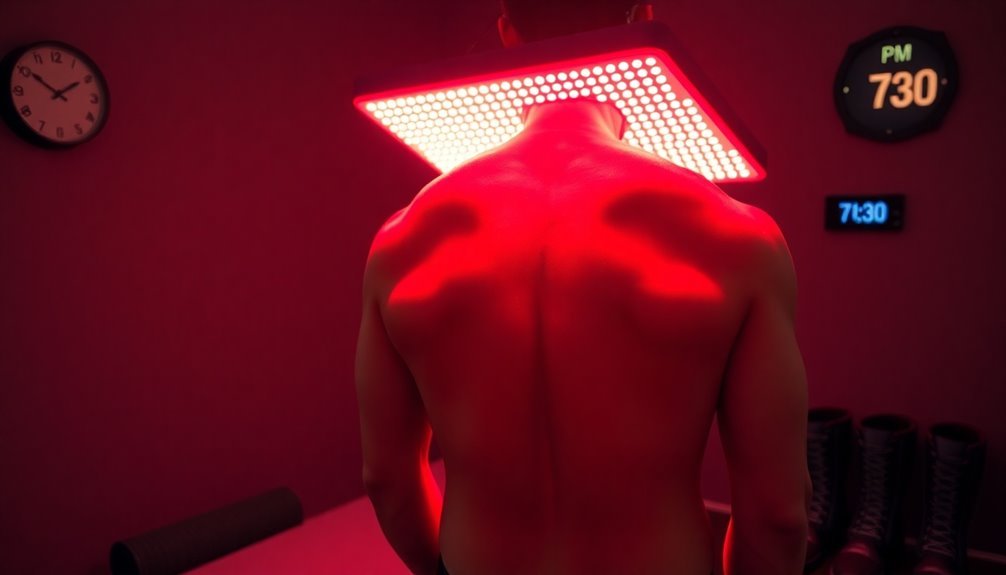
The timing of your photobiomodulation (PBM) sessions can substantially impact their effectiveness for exercise recovery. Research shows you'll get the best results by applying PBM 3-6 hours before your workout, with benefits lasting up to 54 hours post-treatment. Studies demonstrate that using wavelengths of 810nm provides optimal results for delaying muscle fatigue.
If you're short on time, even a 5-minute pre-exercise session can improve your maximum voluntary contraction and reduce muscle damage.
For post-exercise recovery, you'll want to use PBM either immediately after or within 2-3 minutes of completing your workout. This timing helps reduce creatine kinase activity and enhances muscle recovery.
You might see even better results by combining pre- and post-exercise treatments, as this approach has shown significant improvements in oxygen consumption and exercise endurance.
Keep in mind that PBM's effects aren't permanent – they typically last between 48-54 hours. Don't wait longer than 24 hours before exercise to apply pre-workout treatment, as the benefits start to diminish.
While these timing guidelines serve as a general framework, you'll need to take into account your individual response, exercise type, and athletic level when planning your PBM sessions.
Optimal Light Wavelengths For Recovery
When you're looking to optimize your workout recovery, understanding light wavelengths becomes essential. Near-infrared (NIR) light between 800-1000nm penetrates deeply into muscle tissue to accelerate healing and reduce inflammation. These wavelengths stimulate ATP production through interactions with mitochondrial cytochrome C oxidase.
Red light in the 630-850nm range complements NIR by targeting surface tissues and promoting collagen production, while combining both wavelengths creates a synergistic effect.
You'll get the best results using devices that offer both 810nm and 980nm wavelengths, as this combination maximizes cellular stimulation and oxygen delivery to your recovering muscles.
Near-Infrared Benefits (630-850nm)
Light waves between 630-850nm penetrate deep into muscle tissue, offering powerful benefits for workout recovery. When you expose your muscles to these wavelengths, you'll experience enhanced cellular energy production through increased ATP, leading to better endurance and faster recovery times.
Through a process called oxidative phosphorylation, your cells can generate more energy to fuel muscle repair and growth. The light therapy also boosts oxygen consumption in your muscles while improving blood circulation, ensuring essential nutrients reach the areas that need repair.
Different wavelengths within this range provide specific benefits. At 630-680nm, you'll stimulate cytochrome c oxidase, which drives ATP production for energy. The 810nm wavelength effectively targets joint and muscle pain, while 830nm helps prevent scarring and reduces post-workout discomfort. At 850nm, you'll get powerful anti-inflammatory effects that speed up recovery.
You can maximize results by using combination therapy, such as pairing 630nm with 810nm wavelengths.
This therapy's effectiveness is particularly notable during high-intensity training periods. It reduces oxidative stress, decreases inflammation, and enhances cellular communication within your muscle tissue.
Red Light Range Effects
Ideal red light wavelengths between 600-700nm offer powerful recovery benefits for athletes and fitness enthusiasts. The most effective range for muscle recovery falls between 630-660nm, delivering peak cellular stimulation without excess heat generation. Near-infrared light wavelengths between 810-850nm penetrate deeper into tissues for enhanced therapeutic effects.
When you're using LED devices, aim for a power output of 10-35 mW to achieve the best results without risking tissue damage.
You'll get the most benefit from red light therapy by applying it either pre- or post-workout. Use it 5 minutes to 6 hours before exercise to enhance performance and reduce injury risk, or immediately after to accelerate recovery. The effects can last up to 54 hours post-treatment, making it a valuable tool for ongoing recovery support.
For maximum effectiveness, keep your treatment sessions between 5-15 minutes and target specific muscle groups you've worked. The therapy works by boosting your body's ATP production, enhancing protein synthesis, and reducing oxidative stress.
You'll experience faster muscle regeneration, decreased soreness, and improved blood circulation. Research consistently shows that red light therapy outperforms traditional recovery methods like ice baths in reducing muscle damage markers such as blood lactate and creatine kinase.
Combined Wavelength Treatment Protocols
For maximum recovery benefits, combining specific red and near-infrared light wavelengths creates a powerful synergistic effect. You'll want to focus on wavelengths between 630-700 nm (red light) and 700-1200 nm (near-infrared light), with ideal ranges at 630-660 nm and 810-850 nm. These specific wavelengths penetrate your skin effectively to target deep tissue recovery. Cytochrome c oxidase absorbs these wavelengths to enhance mitochondrial efficiency and cellular repair.
When you combine red and near-infrared light, you'll boost your body's natural recovery processes through enhanced ATP production and reduced oxidative stress. This dual-wavelength approach enhances cellular communication and accelerates muscle repair.
| Timing | Duration | Benefits |
|---|---|---|
| Pre-workout | 5-10 mins | Boosts ATP production, reduces injury risk |
| Post-workout | 10-20 mins | Reduces inflammation, speeds muscle repair |
| Injury rehab | 15-30 mins | Accelerates healing, decreases pain |
Position yourself 6-12 inches from the device for best light penetration. For general recovery, aim for 3-4 sessions per week. If you're training intensively or recovering from an injury, you can safely increase to daily sessions. This combined wavelength approach won't just reduce muscle soreness – it'll enhance your overall athletic performance and speed up your recovery time.
Strategic Body Part Targeting
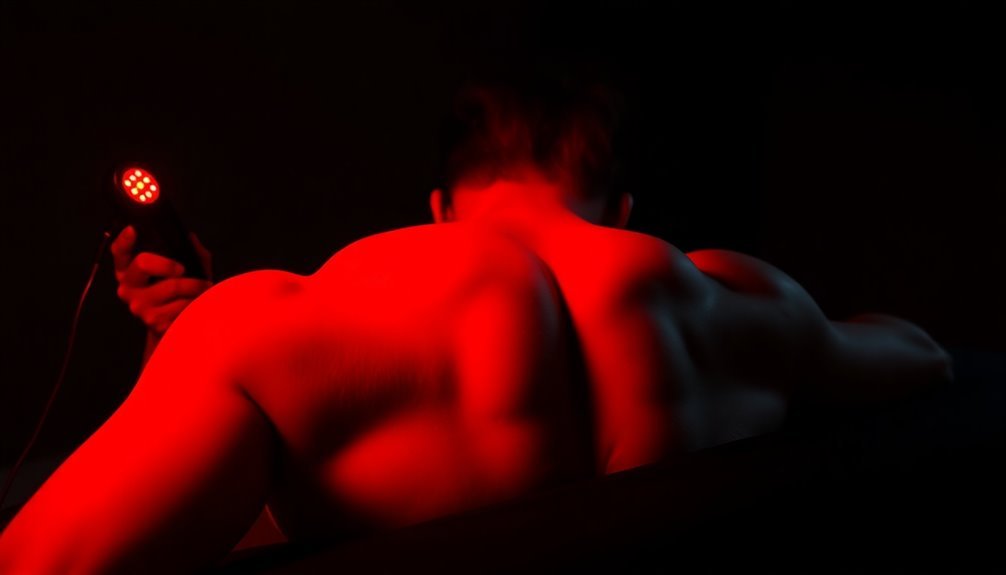
Start your PBM targeting with the largest muscle groups you've trained, like the chest, back, or quadriceps, as these areas typically experience the most significant exercise-induced damage.
You'll want to focus next on specific spots where you're feeling post-workout soreness or fatigue, such as biceps after an arm workout or calves following leg training. PBM therapy helps accelerate muscle healing and reduces inflammatory markers in these areas.
For thorough recovery, don't forget to include your joints and tendons in your PBM treatment, especially if you've done heavy lifting or high-impact exercises.
Major Muscle Groups First
When approaching photobiomodulation therapy for workout recovery, targeting major muscle groups first maximizes the treatment's effectiveness. You'll want to focus on key areas like your quadriceps femoris and hamstring muscles, as these large muscle groups play a vital role in strength and mobility.
Start with bilateral application on your thighs, ensuring you're covering both the front and back surfaces for uniform benefits.
Next, target your lower leg muscles, including the tibialis anterior, gastrocnemius, and soleus. These muscles are essential for overall function and stability.
Don't forget to include your arms and forearms, as strengthening these areas can markedly improve your grip strength and upper body performance. This approach has been shown to increase muscle strength by up to 12 percent compared to non-treated muscles.
For ideal results, use a combination of red and near-infrared LEDs (635 nm and 880 nm) during your 15-minute sessions. You'll achieve the best outcomes by maintaining a total irradiance of 2,073.6 Joules per session.
This approach stimulates your mitochondrial photo-acceptors, enhancing ATP production and promoting cellular repair.
Post-Exercise Hot Spots
Strategic targeting of post-exercise hot spots requires precise attention to areas experiencing heightened muscle tension and fatigue. You'll want to focus your photobiomodulation therapy (PBMT) treatment on specific muscle groups that underwent the most stress during your workout, particularly the quadriceps, hamstrings, and gastrocnemius. Studies show that Class IIIb laser treatments at 850 nm wavelength can provide optimal therapeutic effects.
When treating these hot spots, you'll need to apply PBMT directly to your skin using a cluster applicator at predetermined sites. The therapy works by activating enzymes like cytochrome c oxidase in your mitochondria, promoting cellular regeneration and ATP synthesis.
This targeted approach helps reduce exercise-induced muscle damage and decreases creatine kinase levels, a key marker of muscle stress.
You can choose between targeted or whole-body PBMT treatment, depending on your needs. If you've completed a full-body workout, consider using a light-bed therapy system for thorough coverage.
The timing of your treatment matters too – you can apply PBMT both pre- and post-exercise for best results. While targeted applications help address specific problem areas, whole-body treatment offers a multidimensional recovery approach that helps restore both physiological and psychological resources.
Joint and Tendon Focus
Light therapy precision targeting for joints and tendons represents a crucial component of post-workout recovery. You'll want to focus on specific wavelengths between 660-904 nm, which activate cellular healing mechanisms and boost ATP production in your affected areas.
These wavelengths stimulate collagen synthesis and promote mesenchymal cell growth, essential for repairing damaged tissue.
For best results, you'll need to apply the therapy with specific parameters. Use a power output of about 80 mW for 20-second intervals, three times per week. Your energy density should fall between 1 and 17 J/cm2 when targeting tendons, while small muscle groups respond best to 20-60 J doses.
You can expect several benefits from this targeted approach. The therapy will help reduce muscle soreness, increase your endurance before fatigue sets in, and enhance your overall recovery rate. It's particularly effective during the early stages of healing when your tendons need the most support.
While treatment protocols can vary, maintaining consistency with these parameters will help enhance your recovery process. Remember that proper positioning and regular application are key to achieving the best results.
Combine PBM With Active Rest
Maximizing your workout recovery requires a synergistic approach combining photobiomodulation (PBM) therapy with active rest periods. You'll get the best results by applying PBM both before and after your workouts while incorporating light exercises and stretching during recovery phases.
When you use PBM before exercise, you'll reduce muscle damage and enhance your performance capacity. The therapy works by increasing ATP production and oxygen consumption, which helps delay fatigue and improves your endurance.
After your workout, PBM accelerates recovery by lowering creatine kinase levels and inflammation markers like CRP.
You can use various light sources, including lasers and LEDs, with wavelengths between 630-850nm. During your active rest periods, combine PBM with light movements to enhance the recovery process. This combination not only speeds up muscle repair but also reduces injury time and improves overall physical performance.
Research strongly supports this approach, with numerous studies showing significant improvements in muscle function and recovery markers. You won't experience side effects, making it a safe addition to your recovery routine.
For ideal results, maintain consistency in applying PBM while staying active during rest periods.
Post-Workout Inflammation Management
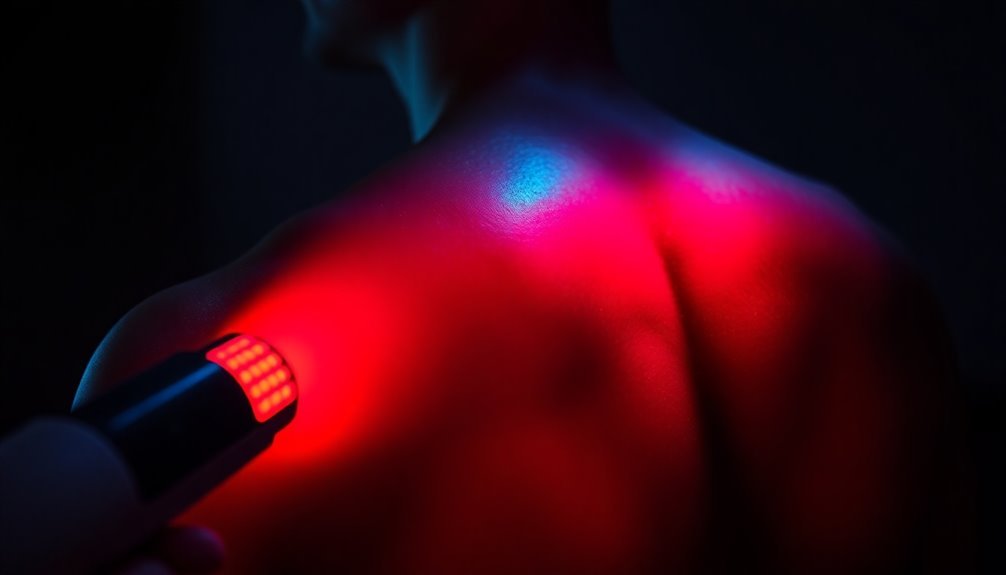
Target PBM therapy directly on your most intensely worked muscle groups to quickly reduce post-exercise inflammation markers like IL-1β and IL-18.
You'll speed up your recovery by applying red or near-infrared light (630-850mm) to these specific areas immediately after your workout, as this wavelength range effectively promotes ATP production and cellular regeneration.
Combining targeted PBM treatment with strategic timing helps minimize muscle damage and accelerates your body's natural recovery processes through enhanced mitochondrial function and reduced oxidative stress.
Targeting Key Inflammatory Sites
During intense workouts, your muscles experience localized inflammation that can hinder recovery and performance. That's where photobiomodulation (PBM) therapy comes in, targeting key inflammatory sites through red and infrared light exposure.
| Treatment Area | Inflammatory Response | Recovery Benefit |
|---|---|---|
| Muscle Tissue | Reduces cytokines | Decreases soreness |
| Mitochondria | Increases ATP production | Enhances energy |
| Blood Vessels | Promotes new red blood cells | Improves circulation |
| Cell Membranes | Reduces oxidative stress | Accelerates healing |
You'll find PBM particularly effective when applied before your workout sessions, as it prepares your muscles for intense activity. The therapy works at the cellular level, specifically targeting your mitochondria where cytochrome c oxidase absorbs the light. This triggers a cascade of beneficial effects, including increased ATP production and reduced oxidative stress.
Unlike traditional methods like cryotherapy, PBM won't compromise your muscle strength between exercise bouts. Instead, it maintains your maximum voluntary contraction while modulating growth factors that support recovery. For ideal results, you'll want to focus the light therapy on areas experiencing the most stress during your workout routine.
Fast-Track Recovery Strategies
Building on our understanding of inflammatory sites, fast-tracking your post-workout recovery requires a strategic approach to PBM application. You'll want to start by applying PBM immediately after your workout when inflammation markers are highest.
Using cluster multi-diode LEDs, target each muscle group for approximately 2.5 minutes with direct skin contact.
To maximize recovery benefits, you'll need to focus on both timing and technique. Apply PBM to multiple regions of the worked muscles, ensuring thorough coverage to reduce key inflammatory markers like TNF-α and IL-1β.
You'll notice better results when you maintain consistent application protocols, as this helps optimize the therapy's biphasic dose response.
For the most effective recovery, combine PBM with your existing recovery routine. While traditional methods like active recovery have their place, PBM offers unique advantages in reducing muscle damage markers such as CK and LDH.
You'll typically experience reduced DOMS and improved countermovement jump performance when following proper protocols. Remember to adjust the wavelength and intensity based on your specific needs, as different muscle groups may respond better to varied technical parameters.
Energy Production Through Light Therapy
Light therapy's remarkable impact on cellular energy production stems from its interaction with the mitochondria, our cells' powerhouses. When specific wavelengths of light (655-950 nm) hit your cells, they stimulate Cytochrome C oxidase, triggering a cascade of beneficial reactions that boost ATP production and enhance cellular metabolism.
You'll experience the most significant benefits when the light therapy follows ideal parameters. For small muscle groups, you'll want to apply 20-60 joules of energy, while larger muscle groups require 60-300 joules.
Your sessions should last 30-60 seconds per area, with a power output of no more than 200 mW per diode.
The increased cellular energy production leads to multiple recovery benefits. You'll notice reduced inflammation as the therapy improves ROS and NO signaling.
Your tissue repair accelerates through enhanced collagen synthesis and fibroblast activity. What's more, the boost in cellular energy helps prevent cell death and restore normal mitochondrial function.
For ideal results in your workout recovery, you can use continuous beam settings for pain relief or pulsed settings when targeting inflammation and tissue repair.
Recovery Between Training Sessions
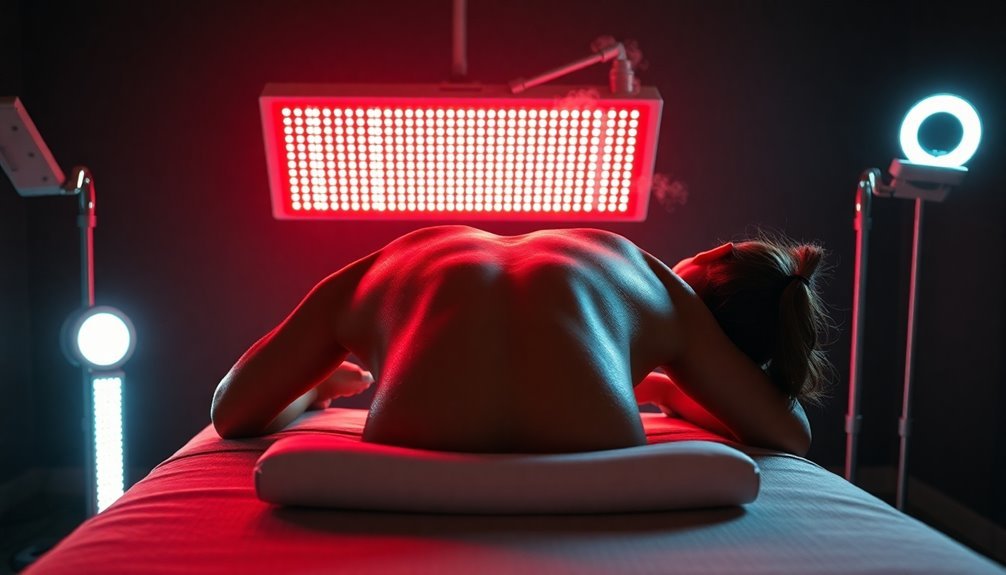
The strategic timing of photobiomodulation therapy between training sessions can dramatically accelerate your recovery process and enhance overall performance. You'll find that applying PBM before your workouts is particularly effective, as it prepares your muscles for exercise and reduces potential damage during training.
When you're looking to maximize your recovery between sessions, PBM therapy offers multiple benefits. It'll help reduce your creatine kinase levels, a key indicator of muscle damage, while simultaneously decreasing inflammation and oxidative stress.
You can expect shorter recovery periods between workouts, allowing you to train more frequently without compromising performance.
You'll notice improvements in muscle function and reduced soreness after implementing PBM therapy into your routine. For the best results, you'll want to maintain consistency with your treatment parameters.
Whether you're focusing on strength training or aerobic exercises, PBM therapy adapts to your needs. You don't need to combine it with other recovery methods like cold-water immersion, as research shows PBM therapy alone provides ideal recovery benefits.
Remember that individual responses vary, so you might need to adjust the treatment protocol to match your specific recovery needs.
Muscle Soreness Prevention Protocol
Preventing muscle soreness through photobiomodulation therapy requires a systematic approach that combines proper timing and targeted application. You'll get the best results by implementing PBM both before and after your workouts, with whole-body treatments showing greater effectiveness than localized applications.
Before exercise, you can use PBM to prepare your muscles for intense training. This pre-workout treatment helps reduce potential injury and shortens recovery time between sessions. During application, focus on using red or near-infrared light, as these wavelengths effectively penetrate muscle tissue and enhance mitochondrial function.
To maximize your results, target specific muscle groups you'll be working during your session. The therapy works by boosting ATP production, reducing oxidative stress, and promoting better cellular regeneration.
You'll want to maintain consistent treatment protocols, as this helps your body adapt and respond more effectively to the therapy.
For ideal prevention, combine PBM with other recovery techniques. Monitor your body's response and adjust the treatment duration and intensity accordingly. While individual results may vary, you'll typically notice reduced muscle damage markers and decreased inflammation when following a regular PBM protocol.
Performance Enhancement With PBM
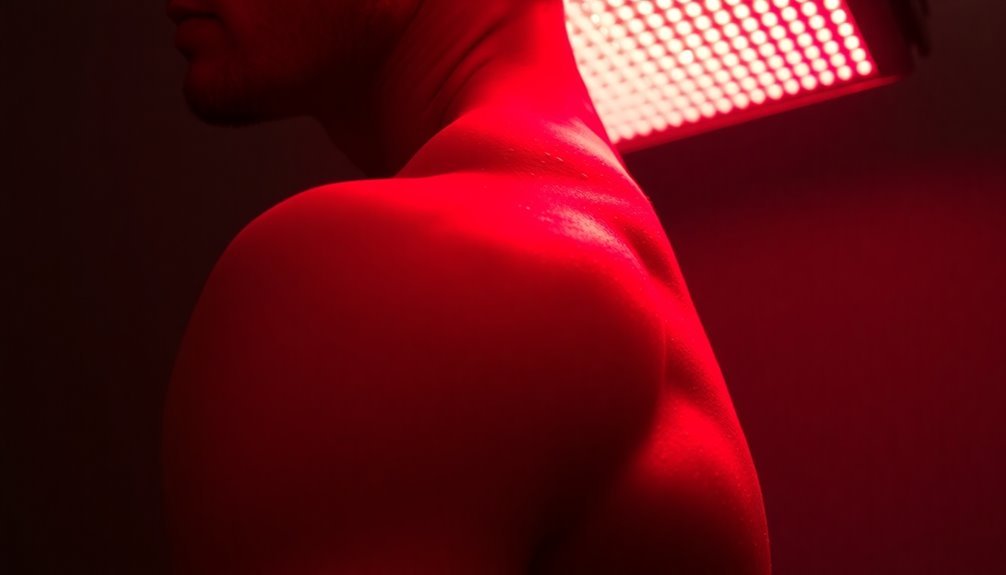
Athletes seeking a competitive edge will find photobiomodulation therapy to be a powerful performance enhancer. When you combine PBM with your warm-up routine, you'll experience increased ATP production and enhanced electron flow in your mitochondria, leading to better energy output during high-intensity exercises.
Studies show that PBM improves your metabolic economy and reduces blood lactate levels, allowing you to train harder and longer.
You can apply PBM both before and after your workouts for maximum benefits. Pre-workout applications help delay fatigue and boost your performance, while post-workout treatments accelerate recovery and reduce muscle soreness. This non-invasive therapy's versatility makes it particularly valuable for high-intensity sports.
Here's what you can expect from regular PBM use:
- Increased distance covered during intense interval training, as demonstrated in the YYIR1 test
- Higher number of repetitions at maximal power output during strength training sessions
- Faster recovery between training sessions with reduced muscle soreness and improved range of motion
While research continues to optimize PBM protocols, current evidence strongly supports its effectiveness in enhancing athletic performance and recovery capabilities.
Long-Term Recovery Benefits
Beyond immediate performance gains, photobiomodulation therapy offers substantial long-term recovery advantages that transform how your muscles heal and adapt. When you use PBM consistently, you'll benefit from reduced muscle damage and enhanced tissue repair through multiple mechanisms.
The therapy boosts your ATP production while minimizing oxidative stress, creating ideal conditions for muscle recovery.
PBM's ability to modulate inflammation is particularly valuable for long-term benefits. You'll experience less edema and muscle necrosis, while the therapy actively supports the distribution of collagen and increases blood capillaries in your recovering muscles.
Clinical trials have consistently shown that when you apply PBM before exercise, you'll notice improved muscle performance and decreased inflammation markers.
What's especially reassuring is PBM's proven safety profile. You won't have to worry about toxicity or adverse effects, even with extended use. Whether you're young or older, you can confidently incorporate PBM into your recovery routine.
For best results, you'll want to follow specific treatment protocols, particularly focusing on pre-exercise application. This approach helps protect your muscles before they're stressed and supports their long-term adaptation to training.
Frequently Asked Questions
Can PBM Therapy Interfere With Medications or Supplements I'm Taking?
Yes, PBM therapy can interact with immunosuppressants and photosensitizing agents like St. John's Wort. Always tell your healthcare provider about medications you're taking before starting treatment to guarantee safety.
Is PBM Therapy Safe to Use During Pregnancy or While Breastfeeding?
Yes, you can safely use PBM therapy during pregnancy and breastfeeding when following proper guidelines. Don't apply it directly to your abdomen while pregnant, and it's particularly effective for managing nipple pain while breastfeeding.
Does Skin Color or Thickness Affect PBM Therapy Effectiveness?
Yes, your skin color and thickness can affect PBM therapy's effectiveness. You'll need adjusted treatment parameters if you have darker skin, as melanin affects light penetration, and different areas require specific protocols.
How Long Do I Need to Continue PBM Therapy to Maintain Results?
You'll need a consistent PBM routine – daily sessions for the first week, then three times weekly for two weeks. After that, use maintenance sessions 2-3 times weekly to sustain your results.
Are There Any Potential Side Effects From Long-Term PBM Therapy Use?
You'll be glad to know that long-term PBM therapy hasn't shown significant side effects in studies. However, you should stick to recommended doses and parameters to avoid potential overexposure or reduced effectiveness.
In Summary
You'll find photobiomodulation therapy revolutionizes your workout recovery when you follow these evidence-based strategies. From timing your sessions to targeting specific muscle groups, PBM offers a natural way to bounce back faster and train harder. By incorporating these tips into your fitness routine, you'll experience reduced inflammation, faster healing, and enhanced performance. Make PBM part of your recovery toolkit to maximize your training potential and achieve better results.

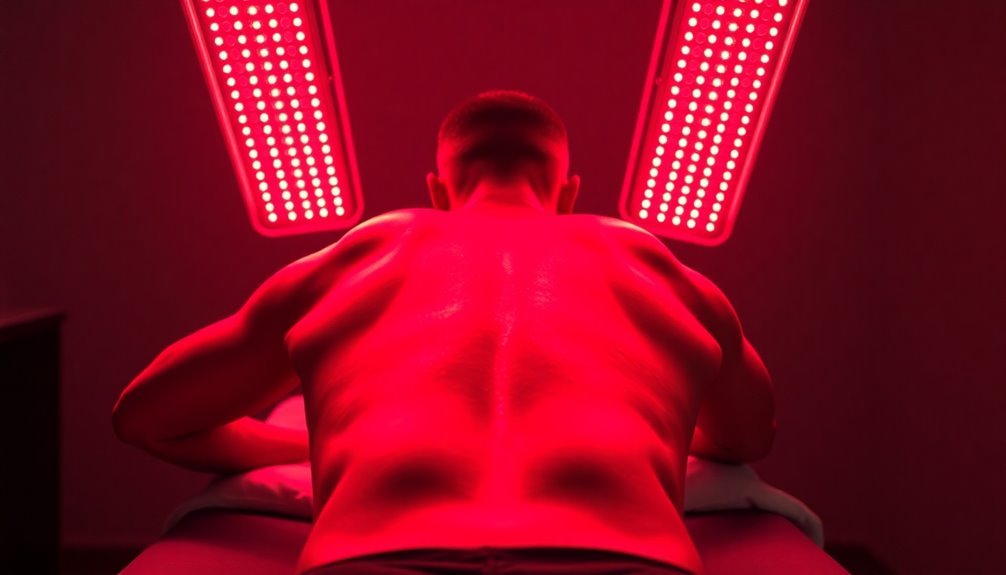



Leave a Reply